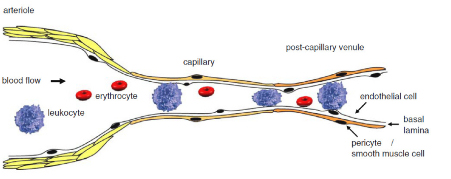
Introduction & Mission
Vasculature directed therapies for the treatment of cancer and chronic inflammatory diseases
In many diseases, the endothelial cells lining the blood vessel walls play an important role in disease initiation, progression and / or maintenance. They are actively involved in angiogenesis, the formation of new blood vessels from pre-existing ones, to continuously supply sufficient nutrients and oxygen to the sites of tumor growth in cancer, and in loss of vascular integrity in inflammation. Furthermore, they facilitate leukocyte recruitment from the blood into inflamed tissues by expressing cell adhesion molecules such as E-selectin, VCAM-1 and ICAM-1, and cytokines and chemokines (fig. 1). The location of the endothelium in the body makes them easy accessible for (targeted) drugs administered via the systemic circulation. Moreover, by aiming at the endothelium, the major hurdle that is generally experienced for drug targeting strategies aimed at cells beyond the vascular wall is eliminated.

A). Endothelial cells are important for pro-angiogenic tumors to grow beyond the size of ~2 mm in diameter. Upon tumor growth related induction of hypoxia, the endothelium proliferates, migrates, and forms a new blood vessel, a process called angiogenesis. The direct dependence of tumor cell proliferation on new blood vessel formation makes the tumor blood supply an attractive target for therapy (from: Grant & Kleinman, EXS 79, 1997).
B). Scanning electron microscopy image of leukocytes interacting with endothelial cells for recruitment into specialized areas in the body. Inhibition of leukocyte – endothelial cell interaction by (targeted) pharmacological interference with endothelial cell activation may lead to diminished inflammation.
The research in the laboratory for Endothelial Biomedicine & Vascular Drug Targeting research, focuses on understanding organ specific, microvascular endothelial cell behavior in (inflammatory) diseases and cancer, and on the development of therapeutic strategies to successfully interfere with endothelial cell (dys)function. In addition, the role of leukocyte activation in the inflammatory process is taken into account, as both endothelial cells and leukocyte show an intricate interaction at the capillary and postcapillary venules where leukocyte recruitment is generally taking place.
1. Understanding the molecular pathways underlying endothelial cell activation and development of therapeutic strategies that interfere in these pathways.
The main focus of this research is to get insight in the organ and vascular bed specific responses of the endothelium to normal and disease-associated stimuli and to study the effects of therapeutic intervention on these responses.
For in vitro studies , various primary endothelial cell cultures and endothelial cell lines are available through the UMCG Endothelial Cell Facility. For in vivo studies we apply the technique of laser microdissection for the isolation of endothelial cells from normal organ and diseased tissue biopsies. By this means, endothelial cell specific mRNA can be isolated and gene expression profiles of the endothelium can be studied (fig. 2). These studies provide basic information on how endothelial cells behave under normal and diseased conditions.
Furthermore, in vitro and in vivo responses of endothelial cell to drugs / new chemical entities (NCE) interfering with intracellular signaling pathways are being unraveled. Studying (microvascular and organ specific) endothelial cell heterogeneity in behaviour during disease and during drug / NCE treatment will gain insight in the molecular background of success and failure of newly developed treatment strategies. Using the combined in vitro / in vivo set up, new targets for therapeutic intervention in inflammatory diseases and cancer will be explored.
2. The role of leukocyte-endothelial cell interactions on inflammatory processes
At the site of the capillaries and postcapillary venules, the endothelial cells are in close contact with the leukocyte, in quiescent as well as in inflammatory conditions (figure 3).

Figure 3: Leukocytes and endothelial cells exert an intimate interaction in the capillaries and postcapillary venules. Modified from Langenkamp & Molema, Cell Tissue Res 2009.
This implies that changes in leukocyte behavior, including activation under the influence of disease conditions, ageing, or diet, will have ramifications for endothelial cell status as well, and vice versa. Understanding the molecular nature of this interplay will provide an important basis for understanding the contribution of both cells and the identification of new biomarkers of cell priming caused by the different conditions.
3. Development of targeted therapeutic strategies to selectively interfere with endothelial cell (dys)function in diseased organs and tissues.
Local endothelial engagement in disease development provides the opportunity to selectively deliver drugs into the diseased endothelial cell only using targeted drug delivery approaches. For this purpose, we are designing drug targeting constructs specific for inflammatory and angiogenesis associated endothelium. Carriers include a new generation of immunoliposomes called SAINT-O-Somes and amphiphilic complexes harnessed with antibodies specific for epitopes expressed on the diseased endothelial cells only. We study in vitro binding, uptake and routing of targeted delivery devices that contain siRNA to knock out disease related genes and inhibitors of signal transduction pathways aimed at endothelial cells in inflammation. Also therapeutic cargo to induce endothelial cell death is formulated aimed at tumor endothelial cells.
| Last modified: | 09 December 2013 11.00 a.m. |
